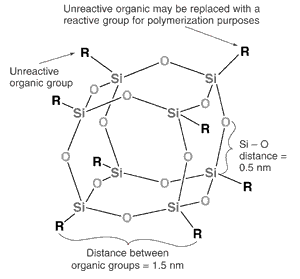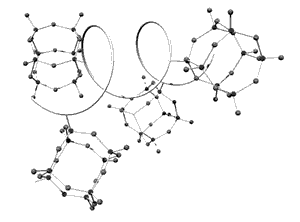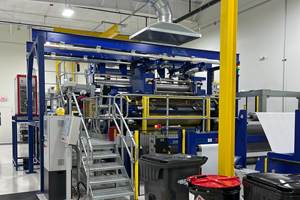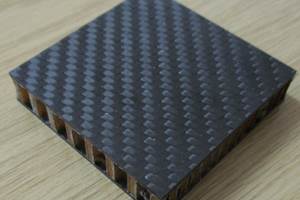Composites Make Large Difference In small Medical, Dental Applications
Surgical instruments and dental restoratives take advantage of polymers with glass-fiber and nanomaterial reinforcements.
Composite materials have enabled significant advances in the medical field. The range of applications is wide, including well-publicized use in orthotic and prosthetic devices and components for large-scale Medical Resonance Imaging equipment. Carbon fiber has cornered the market in many applications, because of its strength-to-weight and strength/stiffness advantages over glass and its transparency in radiological and medical imaging technologies. (For instance, see "Carbon Fiber Prosthetics Make Walking Easier," in sister publication High-Performance Composites, September/ October 2000, p. 39, or see "Focus on Design: Composites Excel in Large-Part Medical Equipment, HPC March/April 1998, p. 64.) But glass-fiber-reinforced composites play a pivotal role in less publicized but critically important arenas where the combination of light weight, good strength and significantly lower cost make it a practical option. And a new class of composite materials resulting from nanotechnology research holds promise for a breakthrough in the field of dentistry.
MINIMALLY INVASIVE SURGICAL PRODUCTS
The trend toward minimally invasive surgery (MIS) — that is, surgical procedures which do not require large incisions and lengthy patient recovery periods — has created a demand for precision instruments that allow a surgeon (with the aid of real-time imaging and/or closed-circuit micro-television viewing technology) to perform critical internal surgical procedures by manipulating control devices outside the patient's body that activate micro-sized surgical instruments at locations nearly anywhere within chest or pelvic cavities. Minimally invasive surgery only requires an incision large enough to allow the passage of small-diameter tubing known as cannula into the body, through which probes (e.g., cauterization devices or even a miniaturized TV camera lens) and/or microsized surgical instruments can be passed. Both the instruments themselves and the cannulas have benefited from innovations in glass fiber-reinforced composites.
The scissors-like, eight-part composite MIS F4 forceps, designed by Surgical Innovations Group plc, (Leeds, England, U.K.,) is one example of the trend toward minimally invasive surgical (MIS) instruments whose ergonomic advantages and multi-purpose functionality derive directly from the freedom of design and light weight of glass-reinforced, injection molded plastic components. Previously, MIS instruments and control mechanisms used in urological and gynecological procedures were designed primarily to accommodate a surgeon's vertical grip, similar to that used when holding a pistol. Feedback from surgeons indicated that using the instrument required a surgeon's entire lower arm to be rotated for even the smallest movement, resulting in arm fatigue.
Surgical Innovations Group, a manufacturer of instruments for MIS and Autologous Blood Tranfusion (ABT) products, designed to recycle the patient's own blood, set out to engineer a more practical control mechanism, but faced significant obstacles in meeting demanding performance requirements. The components for the forceps would need to be precisely manufactured, using materials that would maintain tight dimensional tolerance, possess great strength and have exceptional electomagnetic shielding properties, which ruled out metals. Further, surgical instruments are subjected to extreme temperatures and moisture during repeated autoclave (i.e., pressurized steam) sterilization. Therefore, the material used would have to exhibit very low moisture absorption in order to maintain necessary dimensional stability. Lastly, the company was aware that surgeons, like other consumers, associate aesthetics with quality, so the forceps material would have to maintain a high-quality, blemish-free finish, despite the hard use.
Surgical Innovations opted for the scissors-like handle because it could be operated horizontally, rotated simply by the turn of the surgeon's wrist. The predominant feature of this more ergonomic design was a core component that served as the node or pivot, providing the connection to all other parts.
Composite molder Electromag-Neil Ltd. (ENL, Portsmouth, U.K.) was contracted to fabricate the components in May 1998. Surgical Innovations specified that the assembly be able to withstand 5,000 sterilization cycles in an autoclave (134' @ 2.5 bar). The design for the ergonomic handles called for eight relatively small molded components, which include the central core with stainless steel inserts and a cone that would facilitate rotation and insulate the handle assembly from high voltage during electrocautery (use of electrical current to control internal bleeding). To achieve the strength, dimensional stability and temperature/moisture resistance required in the complex handle of the new forceps, ENL and Surgical Innovations tried a variety of materials. Surgical Innovations originally proposed nylon, but ENL tested glass-filled nylon and found that it lacked sufficient dimensional stability during steam sterilization. Only three other materials met the basic design criteria. Polyetheretherketone (PEEK) easily provided the desired properties — in particular, the moisture and heat resistance — but its cost exceeded the production budget. Liquid crystal polymer (LCP) was unable to meet weld line strength demands and surface appearance requirements. Over a two-year period, Surgical Innovations, ENL and Ticona perfected the design, performing engineering analyses, mold-flow analyses and prototype evaluations, finally settling on Ticona's (Summit, N.J., U.S.A.) Fortron polyphenylene sulfide (PPS) material. The specific molding compound selected was Fortron PPS 9140 L4, a 40 percent glass fiber-reinforced, injection molding-grade linear PPS. The material has sufficient strength for the application (tensile strength of 195 Mpa and a flexural strength of 285 MPa), but cost just 10 percent of PEEK and exhibited significantly less water absorption (0.02 percent) than the original nylon (typical water absorption of nylon 6 and nylon 6.6 is 3.5 percent at 23°C/73°F and 50 percent relative humidity). The glass-reinforced PPS also has superior dielectric and insulation properties, which would come into play when the forceps was used in electrosurgical applications. Further, the Fortron material was moldable within tight tolerances as demanding as 0.05 mm to 0.08 mm (0.002 inch to-0.003 inch), enabling precision fit of the handle components. The forceps handle's eight parts were fabricated in a single mold made by ENL. For the cone component, which was designed for minimal wall thickness, Ticona provided computer-aided flow and structural analyses, using Moldflow software from Moldflow Corporation (Wayland, Mass., U.S.A., which demonstrated that the thin-walled cone would fill out properly with the glass-reinforced PPS during injection. The core, which provides the assembly point for the other components, also presented a challenge. Though most cylindrical parts are injected through gates located in the part center, gating for the core was adjusted so the resin was fed from the end to control formation of weld lines and minimize molded-in stress.
The lightweight, precision instrument, which is available in the Americas and Europe, reduces surgeon fatigue and won two Awards for Excellence (in the medical and overall categories) at Interplas in 1999. The Fortron PPS polymer complies with USP class VI and ISO 10993 requirements, often specified for plastics used for medical applications.
NANOCOMPOSITE DENTAL MATERIALS
Dentists long have been on the lookout for new materials that form better, more long-lasting bonds to tooth enamel than traditional filling materials. Anyone who has had to pay a visit to the dentist to have a loose or lost filling replaced will appreciate ongoing work by Hybrid Plastics (Fountain Valley, Calif., U.S.A.), to develop a material with greater adhesive properties and durability. Hybrid is working with Polyhedral Oligomeric Silsesquioxanes, in its trademarked POSS Nanostructured materials. They believe that the next wave of composites for dental applications is likely to come from the field of nanotechnology. A nanometer is one billionth of a meter, hence, the name nanotechnology.
Nanomaterials have been widely touted as potential building materials for everything from reinforcement additives for conventional composites to the prime building material for massive space "elevators." For the most part, however, nanomaterials are still in the earliest stages of commercial development.
The silsequioxaines have been around since General Electric Co. did some early research in the field in the 1960s, Development didn't take off until Dr. Joseph D. Lichtenhan began work on it at the U.S. Air Force Laboratory at Edwards Air Force Base. In 1998, Lichtenhan and colleague Dr. Joseph Schwab formed Hybrid Plastics on the strength of a $2 million grant from the National Institute of Standards and Technology's Advanced Technology Program. The POSS materials are the result of their collaboration.
Hybrid recently received a $750,000 R&D grant from the National Institute of Dental and Craniofacial Research, part of the U.S. National Institutes of Health (NIH). The Phase II Small Business Innovation Research (SBIR) reward will enable the company to develop a prototype adhesive/restorative system based on work successfully undertaken in a Phase I SBIR. Hybrid Plastics has teamed with the College of Dentistry at Ohio State University and the Pentron Corporation (Wallingford, Conn., U.S.A.) a leading dental materials supplier, to develop this technology on this NIH grant. The goal is to provide a system that can deliver near revolutionary performance in bonding, shrinkage control and resistance to deterioration. The mouth is a surprisingly aggressive environment. Teeth must withstand mechanical stress, wear and corrosion from an acidic, hot, wet environment. POSS, according to Hybrid Plastics, is a true nanostructured chemical. "The material is an organic/inorganic hybrid molecule," says Carl Hagstrom, chief operating officer for the company. POSS marries the beneficial properties of plastics, processability and toughness, with ceramic hardness and stability. The basic POSS molecule is a polyhedral structure (see diagram, this page) made of silicon and oxygen, which forms the nanoscopic, hollow inorganic core of the material. Roughly spherical in shape, the basic structure is cage-like, with vertices that provide attachment points for various organic groups. The compatibility of the basic POSS structure with a variety of organic materials allows the design of POSS molecules, which can be tailored to impart unique performance characteristics when paired with a polymer in a composite. While the inorganic cage component lends the structure some of the properties of a particulate, Hagstrom maintains that "the materials can do more than a particulate filler because they both dissolve and can be polymerized into the resin system, so that they actually can become part of the polymer "backbone" of the material. We can make the molecules themselves compatible with the material with which it will be paired," says Hagstrom.
A direct benefit of POSS used in dental applications is improved adhesion between the restorative compound and the natural tooth at the bondline. Adhesion is, in large part, a function of good contact between the surfaces to be bonded. Ordinarily, the greater the surface area of the contact interface, the stronger the overall bond. Adhesion problems occur in teeth because currently used restorative materials differ dramatically in particle size with the "building blocks" found naturally in human teeth. What dentists really need is a restorative system that mimics the tooth's natural range of structure sizes — the restorative system will then maintain what Hagstrom calls "continuum of structure." Natural tooth material contains both nanoscopic material (where the material ranges in size from 1 nm to 10 nm in all three dimensions) and macroscopic components (40 nm to 0.7µm). Current restorative materials contain a large proportion of macroscopic materials. The size differential has a negative impact on adhesion between the tooth and synthetic restorative materials.
Microscopically speaking, the surface of a tooth isn't a flat surface. Rather the surface of the tooth interior, when exposed by damage or removal by the dentist's drill, is more analogous to a moonscape with very deep "craters" called tubules. The particulate matter in conventional restoratives is actually too large to flow into the tubules. Instead it bridges them, thus reducing the bondable surface at the tooth interface.
Although relatively large at molecular length scales, the spherical POSS structures are still far smaller than the structures in traditional composite dental replacement materials. The nano-sized materials in the POSS-reinforced restorative composites function as isotropic 1.5 nm structural reinforcements in the base restorative resin. POSS monomer, used as an additive that polymerizes with the restorative resin, will provide a more natural interface between the 2 nm-sized apatite crystals present in natural tooth and the 1 nm to 10 nm structurally controlled restorative resin. The more stable restorative also reduces the risk of adhesion failure due to shrinkage as the material ages. Another benefit is that filling the tubules with POSS reduces tooth sensitivity to hot and cold, eliminating a traditional complaint of dental patients with freshly filled cavities.
With the POSS material's inorganic component, you have toughness; with the organic component, you get processability." Hagstrom explains. This dual functionality and potential for multiple organic "attachments" makes POSS highly customizable.
While POSS has dental and medical applications, it should be noted that it actually is a platform technology with fields as diverse as aerospace and microelectronics. POSS molecules require no special equipment or processes to be added to existing polymer manufacturing processes, according to Hagstrom, who adds that POSS is biocompatible (that is, nontoxic to humans), recyclable, nonflammable and — significantly — priced on a par with the fine polymer feedstocks now used. While solvents are used in their initial manufacture, POSS monomers are, in use, "green" materials that emit no volatile organic compounds (VOCs). The materials are currently made from silanes, a commodity precursor in the silicone manufacturing process. Eventually, Hagstrom says, POSS molecules could be made directly from silica sand, reducing the need for petroleum-based materials in many plastic products.
The challenge, going forward, is to further reduce manufacturing time and costs, a goal toward which Hybrid has made considerable progress. While the first POSS nanomaterials cost $5,000/lb and took three months to make, Hybrid Plastics has reduced costs to as little as $50/lb for some compounds, with production taking less than a single day.
Though prices are still too high for POSS materials to be marketed as commodities, Hagstrom predicts further significant price reductions as the company achieves economies of scale. "We got to the point last year where we were reaching price points that were commercially viable," he says. Hybrid is currently looking to set up a rollout manufacturing facility and technical support center in Hattiesburg, Miss., U.S.A.
Related Content
Henkel releases digital tool for end-to-end product transparency
Quick and comprehensive carbon footprint reporting for about 58,000 of Henkel’s adhesives, sealants and functional coatings has been certified by TÜV Rheinland.
Read MoreSyensqo introduces AeroPaste 1003 aerospace adhesive
Two-part room-temperature paste increases high-rate assembly and joining efficiencies when bonding metallic and composite parts.
Read MorePark Aerospace launches aerospace, MRO structural film adhesive
Aeroadhere FAE-350-1 is a curing epoxy formulation designed for composite, metal, honeycomb and hybrid applications.
Read MorePRF Composite Materials introduces primer, adhesive films
Novel RFA570 eXpress cure adhesive film and RF Primer are compatible with PRF’s full range of epoxy prepregs formulations.
Read MoreRead Next
Developing bonded composite repair for ships, offshore units
Bureau Veritas and industry partners issue guidelines and pave the way for certification via StrengthBond Offshore project.
Read MoreAll-recycled, needle-punched nonwoven CFRP slashes carbon footprint of Formula 2 seat
Dallara and Tenowo collaborate to produce a race-ready Formula 2 seat using recycled carbon fiber, reducing CO2 emissions by 97.5% compared to virgin materials.
Read More“Structured air” TPS safeguards composite structures
Powered by an 85% air/15% pure polyimide aerogel, Blueshift’s novel material system protects structures during transient thermal events from -200°C to beyond 2400°C for rockets, battery boxes and more.
Read More
























